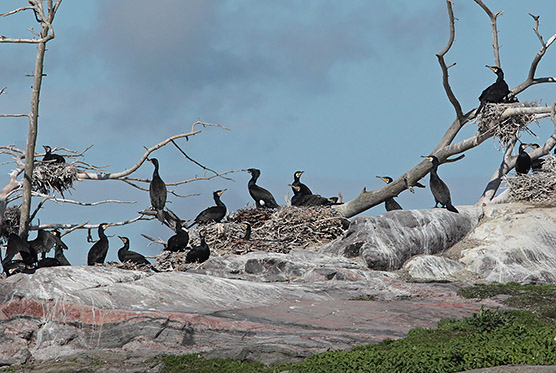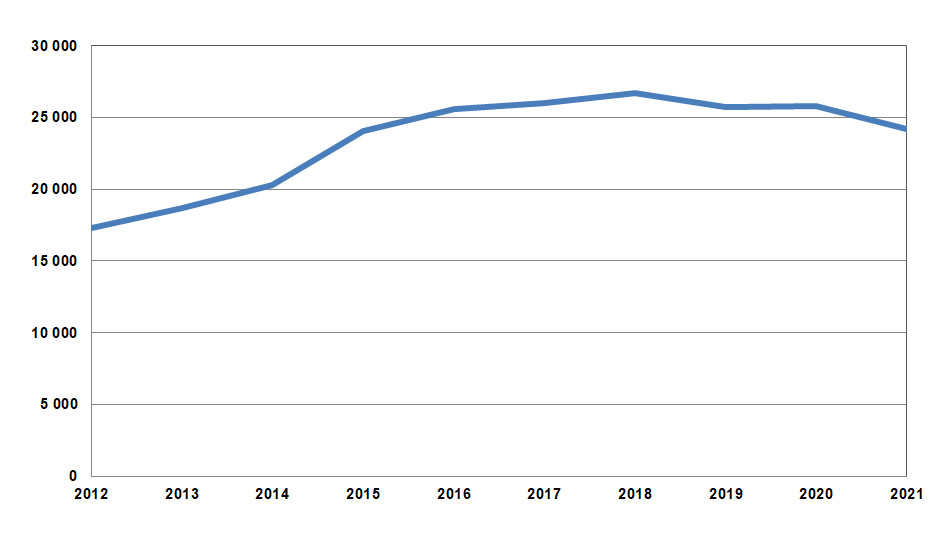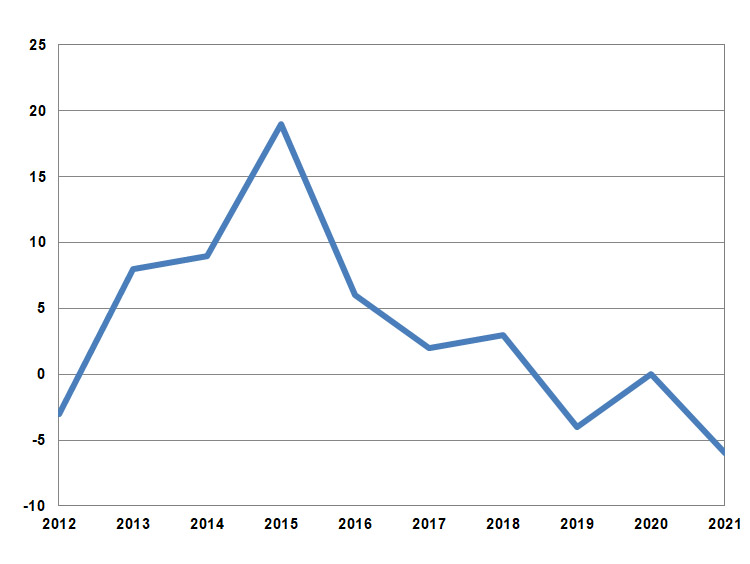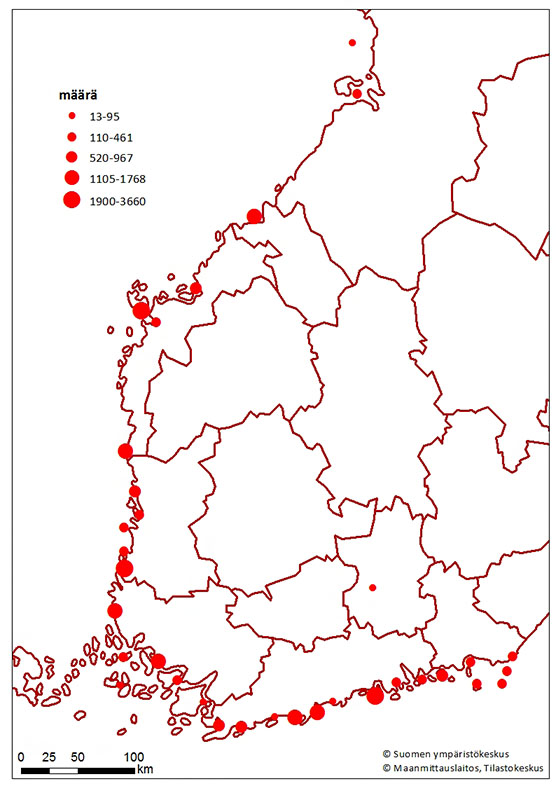Press release 2021-08-18 at 15:45
Approximately 24,300 cormorant nests were counted in Finland in the summer of 2021. The first successful inland nesting was confirmed in Päijät-Häme. The nesting population in Finland has varied by only a few per cent since 2015. However, the number of nests per year varies greatly regionally, and the white-tailed eagle’s hunting has an increasing impact on the fledgling production and the locations of the colonies.

Photo Heikki Kotiranta
Finland’s nesting population decreased by six per cent (about 1,500 nests) from the previous summer. One third of the cormorant nests were located in the Gulf of Finland, a fourth in the Bothnian Sea, one fifth in the Archipelago Sea, 12 per cent in the Northern Quark and eight per cent in the Bothnian Bay. The population decreased by 13 per cent in the Bothnian Sea, 12 per cent Northern Quark, six per cent in the Gulf of Finland and one per cent in the Archipelago Sea. In the eastern part of the Gulf of Finland, the population was almost halved. The population grew only in the Bothnian Bay, by 36 per cent.
All in all, the cormorant population in the Gulf of Bothnia decreased by seven per cent to approximately 11,300 nests, with 6,680 located in the Bothnian Sea, 2,800 in the Northern Quark and 1,850 in the Bothnian Bay. In the Gulf of Finland, the population comprised approximately 8,000 nests and in the Archipelago Sea, 4,950 nests.
A small colony in lake Vesijärvi in Lahti had 13 successful cormorant nests. The colony near the coast in Pori, which settled at a small lake inhabited by a variety of birds last summer, grew to 460 nests.
Largest colonies are far away from each other
A total of 61 cormorant colonies were observed in Finland on 97 islets or islands. In Ii in the Bothnian Bay, a small group of cormorants had been nesting on four leading marks. The number of colonies was higher than in previous years, but 40 per cent of all colonies had less than 100 nests.

Number of cormorant nests 2012–2021
More than half of the entire population nested in the seven largest colonies. Colonies of more than one thousand nests were located in Rauma (around 3,660 nests), Turku (1,770), Mustasaari (1,740), Porvoo (1,730), Kirkkonummi (1,590), Kristiinankaupunki (1,240) and Uusikaupunki (1,160). The distance between the largest colonies varied between 40 and 150 kilometres.
At the municipal level, the populations decreased significantly, with approximately 900–1,100 nests in Virolahti, Loviisa and Eurajoki. The populations decreased also in Uusikaupunki and Vaasa, by approximately 400–550 nests. The populations grew the most in Porvoo, Espoo, Kristiinankaupunki, Kokkola and Mustasaari, by around 350–450 nests.
Entirely new colonies were found in Kotka, Porvoo, Inkoo, Mustasaari and li. Seven colonies from the previous year were abandoned, and an equal number were found to be nesting in former places after one or more years’ breaks.
Individual colonies in Virolahti, Loviisa and Pori were disturbed illegally. The colony evicted from the archipelago in the western part of Loviisa was interpreted to have moved to the inner archipelago of Porvoo, on two forested islands, forming a colony of over 300 nests. There were also indications of disturbance in Mustasaari and the eastern part of Loviisa.
White-tailed eagle is hunting more and more
Hunting by the white-tailed eagle continued to increase, weakening the fledgling production even in large colonies. As a result, a relatively smaller number of cormorants will return to their birth regions in the coming years. Hunting by the white-tailed eagle also affects the locations of the colonies and their way of nesting: nesting is increasingly concentrated in the inner archipelago and the proportion of nesting in forests is growing.

Percentage increase in the cormorant population 2012–2021
Eurajoki, Pori and Uusikaarlepyy had the most extensive failure of nesting due to the white-tailed eagle. Only some 450 pairs dared to nest in Eurajoki, but the nesting failed. The same two colonies had nearly 1,600 nests combined in the previous summer. The number of nests in the archipelago colony in Pori decreased by one third due to the white-tailed eagle, and nearly half of the almost 900 nests failed. At most, a quarter of the over 500 nests in Uusikaarlepyy were successful.
The share of cormorants nesting in trees has been clearly increasing since the previous summer, and just under half of the nests were in trees this summer. However, the areas are small: on forested islands of at least half a hectare (16 in total from Porvoo to Rauma) the nesting area covered about 28 hectares. The total area was about 32 hectares when the smaller forested parts of all nesting islets were included. The total nesting area of the Finnish cormorant population was about 75 hectares.
Nearly 90 people participated in the calculations, searches and checks of cormorant colonies in the summer of 2021.

Number of cormorant nests by region 2021
Cormorant monitoring is conducted to collect basic information about the ecology and spreading of the species in Finland. The cormorant is protected in Finland throughout the year under the Nature Conservation Act, and it is not on the EU's list of huntable species.
Inquiries
Pekka Rusanen, Researcher, Finnish Environment Institute SYKE, tel. +358 400 148 691, firstname.lastname@syke.fi
Markku Mikkola-Roos, Senior Coordinator, Finnish Environment Institute SYKE, tel. +358 400 148 685, firstname.lastname@syke.fi